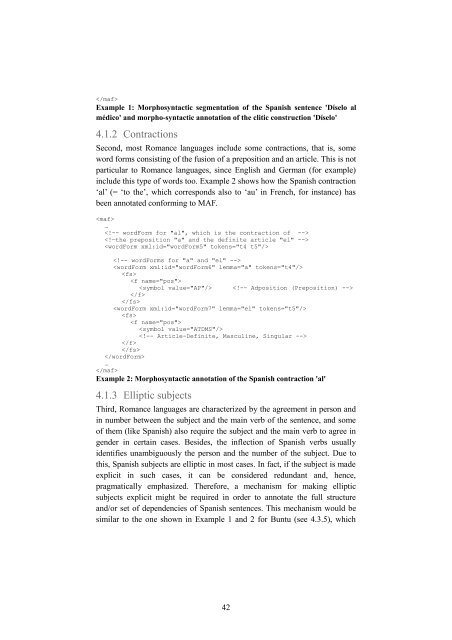A Treebank-based Investigation of IPP-triggering Verbs in Dutch
A Treebank-based Investigation of IPP-triggering Verbs in Dutch
A Treebank-based Investigation of IPP-triggering Verbs in Dutch
Create successful ePaper yourself
Turn your PDF publications into a flip-book with our unique Google optimized e-Paper software.
Example 1: Morphosyntactic segmentation <strong>of</strong> the Spanish sentence 'Díselo al<br />
médico' and morpho-syntactic annotation <strong>of</strong> the clitic construction 'Díselo'<br />
4.1.2 Contractions<br />
Second, most Romance languages <strong>in</strong>clude some contractions, that is, some<br />
word forms consist<strong>in</strong>g <strong>of</strong> the fusion <strong>of</strong> a preposition and an article. This is not<br />
particular to Romance languages, s<strong>in</strong>ce English and German (for example)<br />
<strong>in</strong>clude this type <strong>of</strong> words too. Example 2 shows how the Spanish contraction<br />
‘al’ (= ‘to the’, which corresponds also to ‘au’ <strong>in</strong> French, for <strong>in</strong>stance) has<br />
been annotated conform<strong>in</strong>g to MAF.<br />
<br />
…<br />
<br />
<br />
<br />
<br />
<br />
<br />
<br />
<br />
<br />
<br />
<br />
<br />
<br />
<br />
<br />
<br />
<br />
<br />
…<br />
<br />
Example 2: Morphosyntactic annotation <strong>of</strong> the Spanish contraction 'al'<br />
4.1.3 Elliptic subjects<br />
Third, Romance languages are characterized by the agreement <strong>in</strong> person and<br />
<strong>in</strong> number between the subject and the ma<strong>in</strong> verb <strong>of</strong> the sentence, and some<br />
<strong>of</strong> them (like Spanish) also require the subject and the ma<strong>in</strong> verb to agree <strong>in</strong><br />
gender <strong>in</strong> certa<strong>in</strong> cases. Besides, the <strong>in</strong>flection <strong>of</strong> Spanish verbs usually<br />
identifies unambiguously the person and the number <strong>of</strong> the subject. Due to<br />
this, Spanish subjects are elliptic <strong>in</strong> most cases. In fact, if the subject is made<br />
explicit <strong>in</strong> such cases, it can be considered redundant and, hence,<br />
pragmatically emphasized. Therefore, a mechanism for mak<strong>in</strong>g elliptic<br />
subjects explicit might be required <strong>in</strong> order to annotate the full structure<br />
and/or set <strong>of</strong> dependencies <strong>of</strong> Spanish sentences. This mechanism would be<br />
similar to the one shown <strong>in</strong> Example 1 and 2 for Buntu (see 4.3.5), which<br />
42
















